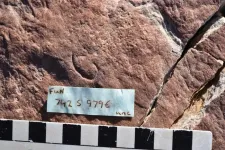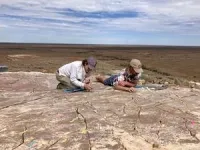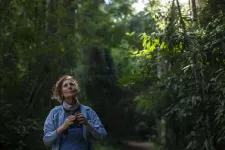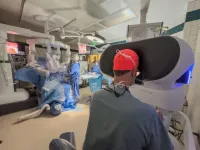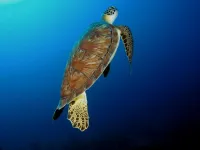(Press-News.org) A groundbreaking fossil discovery in remote South Australia sheds light on one of evolution’s greatest mysteries: the origins of Ecdysozoa, a superphylum of molting animals including insects, crustaceans, and nematodes.
Ecdysozoans are the largest, most species-rich animal group on Earth. Although more than half of all animals are ecdysozoans, scientists have long grappled with the lack of evidence of ecdysozoan ancestors in the fossil record, despite molecular evidence suggesting they should exist in the Precambrian.
Now, in a new study published in Current Biology, researchers describe Uncus dzaugisi, a 555-million-year-old worm-like organism preserved in the Precambrian rocks of Nilpena Ediacara National Park (NENP). This tiny fossil, barely over a few centimeters long, represents the oldest confirmed member of the Ecdysozoa and the only one known from the Precambrian period.
“It’s an incredibly exciting discovery,” said lead author Ian Hughes, a Ph.D. candidate in the Department of Organismic and Evolutionary Biology at Harvard. “Ecdysozoans were prevalent in the Cambrian fossil record and we know they didn’t just appear out of nowhere. But, until now, we had no concrete fossil evidence to confirm it.”
Hughes discovered Uncus in the Precambrian sandstone rocks at NENP, a site renowned for its exceptionally well-preserved Ediacaran lifeforms. Once an ancient seafloor, the park is dedicated to the research and preservation of Ediacaran fossils found in the sandstone sediments in the area. The site’s fine-grained sediments actually allowed for the extraordinary preservation and detail of Uncus.
“A lot of the beds that we have are relatively coarse-grained,” said Hughes, “but the sandstone in several new beds at Nilpena is so fine-grained that it allows for finer details and preservation of smaller animals.” The researchers worked carefully, using hand tools to dig into the rocky hillside. The Ediacaran seafloor reveals a time before animals began burrowing up and down between sediment. The top few ancient millimeters were covered in thick microbial mat materials where these first animals lived. Eventually, sediment covered and compressed these communities, creating a mold of their ancient ecosystem.
“Imagine pouring concrete over the ocean, waiting a half-billion years, and then flipping it over to find an entire ecosystem,” Hughes said. “That’s what’s really unique about this locality. Because they were all smothered at the same time, we can actually also conduct ecological work on the first animal ecosystems on Earth.”
There are over one hundred genera of Ediacaran fossils, yet none had ever been confidently assigned to the Ecdysozoa. The discovery of Uncus helps address the dilemma of the origins and rapid diversification of the Ecdysozoa lineages in the Cambrian. For the first time, Uncus offers direct evidence of early ecdysozoan life forms from the Precambrian.
The fossil’s unique features—including its cylindrical body, a consistent length-to-width ratio, remarkably rigid cuticle, and distinct curved traces indicating motility—point to similarities with modern nematodes. The team was especially excited to find trace fossils, as unlike many of its squishy contemporaries, which were not especially mobile, Uncus was quite active. It wasn’t until the researchers moved to a different section of the site in 2019 and found a shift in the composition of the microbial mat that they were able to see the ecdysozoan fossils and traces that revealed this ancient species and its motility.
“It’s a remarkable find, as it places Ecdysozoans in the Precambrian Eon, supporting the theory that this lineage predates the Cambrian explosion,” said Hughes. “Ecdysozoans are so diverse and occupy so many niches, that to actually identify an early one and see what Ecdysozoans were doing is just amazing.”
Nilpena Ediacara National Park (NENP) is more than a field site for Hughes and the team – it’s been a part of Hughes and his family’s lives for 25 years. After so many years of working there, Hughes and his family have built a deep relationship with the indigenous community and the cattle ranch owners who sold part of their land to develop NENP and preserve the Ediacaran fossils. Hughes and his team are very careful to not disturb the structure and layout of the park, as no rock is allowed to be removed from the site.
With a grant from NASA, they were able to secure a 3D laser scanner that provides high-resolution images of all of their findings in the field. “We do everything we can to make sure every rock stays on site,” said Hughes, “The only exception is if we discover and describe a new species. Then, we deposit a holotype in the Museum in South Australia. This is really important to our work ethic, to not disrupt the land that belongs to the indigenous people.”
Moving forward, the researchers plan to use the laser scan data to study the curvature and movement of this species. “Uncus body fossils and associated trace fossils give us a really unique opportunity to look in detail into the sinuosity and curvature to model the potential musculature of this ancient species,” Hughes said. “Moreover, because these fossils are preserved on fossil bed surfaces, we can investigate the ecology of this taxon and try to understand whether its distribution on the seafloor might correlate with another species or a particular type of microbial mat structure.”
Uncus dzaugis is named in honor of Mary, Matthew, and Peter Dzaugis for their past and continuing contributions to fieldwork at NENP
####
END
LAWRENCE, KANSAS — While culture is intertwined with values surrounding food and body image, cultural differences have historically been overlooked by researchers and clinicians seeking to identify and treat eating disorders.
The lack of culturally relevant approaches has been huge barrier for Hispanic, or Latine, women in accessing care, said Sarah Johnson-Munguia, a sixth-year University of Kansas graduate student working in Center for the Advancement of Research on Eating Behaviors (CARE) Lab at the KU Life Span Institute.
Johnson-Munguia is the lead author of a paper published in ...
The findings showed that CBD did not significantly change scan-related anxiety when compared to a placebo, but researchers did find that CBD was safe and resulted in significantly lower overall anxiety levels
Anxiety is extremely common among adults receiving cancer care, with as many as one out of every four patients meeting the clinical criteria for anxiety. Many patients with cancer also experience scan-related anxiety (scanxiety), a condition in which individuals develop anxiety related to getting imaging ...
More than a hundred years ago, astronomer Percival Lowell made the case for the existence of canals on Mars designed to redistribute water from the Martian ice caps to its lower, drier latitudes. This necessarily meant the existence of Martians to build the canals.
While Lowell was proven wrong by better telescopes, the question of whether there’s liquid water on Mars continues to tantalize researchers. Liquid water is a critical precondition for a habitable planet. Yet the combination of low temperature, atmospheric pressure and water vapor pressure on Mars means any liquid water found there would ...
Despite the population being almost four times larger than it was in 1982, a new study published in the journal Ecology suggests the northern muriqui monkeys remain at risk, especially in the face of ongoing habitat disturbances.
Northern muriquis, which live in the Atlantic Forest of Brazil, are much more peaceful and egalitarian compared to other primates. They are also one of the most endangered species of monkey in the world.
Karen Strier, a professor of anthropology at UW–Madison and lead author of the paper, has spent 40 years studying the behavior and ecology of these monkeys in a small, preserved portion ...
University Hospitals is the first health system in Northeast Ohio utilizing the Da Vinci 5 for robotic-assisted surgeries. With substantial improvements over previous models to provide a better experience for surgeons, caregivers and patients, this latest technology represents an evolution in robotic-assisted surgery. Approximately 26 trained surgeons at UH Cleveland Medical Center will be using this robot for a large variety of cases, including esophagectomies and gastric bypasses.
“The adoption of the DV5 is not just about technology – it reflects UH’s strategic investment in the future of robotics,” ...
The Stanford Medicine Alumni Association (SMAA) has selected Chan Zuckerberg Biohub San Francisco President and UC San Francisco Professor Joe DeRisi as a recipient of the Arthur Kornberg and Paul Berg Lifetime Achievement Award in Biomedical Sciences. The annual award honors exceptional career contributions from “the most distinguished Stanford University School of Medicine alumni in the biomedical sciences.”
By the time he earned his Ph.D. in biochemistry from Stanford in 1999, DeRisi was already pioneering DNA microarray technology and whole-genome expression profiling. ...
PHOENIX — Mayo Clinic announces the results of an innovative treatment approach that may offer improvement in overall survival in older patients with newly diagnosed glioblastoma while maintaining quality of life. Glioblastoma is the most lethal type of primary brain cancer due to its aggressive nature and its treatment-resistant characteristics. It is the most common form of primary brain cancer. Each year an estimated 14,500 people in the U.S. are diagnosed with the disease. Results of Mayo ...
BINGHAMTON, NY. -- Senior citizens are targeted by financial scams of all types, from email-based phishing attempts to callers looking to swindle their life savings.
A new paper from Binghamton University Associate Professor of Psychology Ian M. McDonough sheds light on how age-related changes may affect the way we handle finances — and how we can stay sharp as we age. “Separating neurocognitive mechanisms of maintenance and compensation to support financial ability in middle-aged and older adults: The role of language and the inferior frontal gyrus,” co-authored by Macarena Suárez-Pellicioni of the University of Alabama, was recently published ...
What Question Were You Investigating with this Study?
Are there sex-based differences in exposure to light?
Light is an important environmental exposure, as it is the primary cue for the circadian system and has other effects on health. Yet there is limited objective evidence characterizing population-wide personal light exposure patterns.
What Approach Did You Use?
We analyzed real-world light exposure (using wrist-worn devices) collected from 11,314 participants in the 2011 to 2014 U.S.-based National Health and Nutrition Examination Survey, with metrics reflecting the duration of and the timing of ...
R,esearchers from Swansea and Deakin Universities have found that marine animals across mammals, birds and reptiles swim at similar relative depths when travelling and not feeding to save energy.
Dr Kimberley Stokes, Professor Graeme Hays and Dr Nicole Esteban from Swansea and Deakin Universities, led research across six institutes in five countries comparing the swim depths of several sea turtle, penguin and whale species. All travelled at around three body depths from the surface in order to swim in the 'sweet spot' that minimises wave formation at the surface and vertical distance travelled.
Some semi-aquatic animals, such as mink, swim at the surface where wave generation ...
